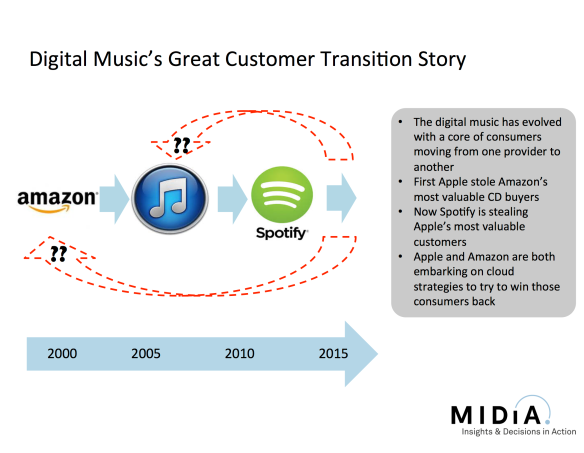The next five years will be one of the music industry’s most dramatic periods of change. The last ten years might have been disruptive but the change that is coming will be even more transformative. By 2019 70% of all digital revenue globally will be from on-demand services, representing 40% of total music revenues. It will be a shift from the old world and the ‘old new world’ to a brave new one. The CD and the download will decline at almost the same rates: physical revenue will be 43% smaller while downloads will be 40% smaller. In some ways the CD has less to worry about than the download. The CD has the protection of a vast installed base of players across the globe and growing niches such as deluxe box sets. The download though depends massively upon Apple’s devices, and the tide over at Cupertino is turning.
One of the concerns of the shift to streaming has been revenue cannibalization. It is no new phenomenon. The paid digital music market has still not truly broken out to the mainstream. While the likes of YouTube and Pandora clearly have mass market reach, music download stores and subscription services do not. Each at their respective times have appealed to the same higher spending and tech savvy end of the music buyer spectrum.
In the 1990’s and early 2000’s Amazon’s online CD store was the home of the globe’s most tech savvy music aficionados. Then Apple came along and poached its iTunes customers directly from Amazon because those same CD buyers were also buying iPods. Then Spotify came along and started poaching Apple’s most valuable customers via Apple’s App Store – the chink in the armour of Apple’s otherwise closed ecosystem.
Now Apple and Amazon are both setting out on their own cloud strategy journeys and each will be hoping to win back a chunk of their lost customers. Apple’s recent elevation of Beats Music to one of the family of ‘Apps Made By Apple’ gives the first hint of what the company can do to ‘encourage’ its users away from other streaming services.
The next three years or so will be a fiercely contested battle for the hearts and minds of the digital music aficionado that will illustrate the strengths and weaknesses of the technology ecosystems of Apple, Amazon and Google. Yet while they all fight to win or win back customers, the attention once again remains firmly on the top end of the market. For as long as music services focus their efforts on the most valuable music customers, the mainstream will continue to be catered by low ARPU ad supported services. And for as long as that happens the evolution of digital music will continue to be one of the latest generation of services stealing the customers of the last.


Pingback: A Journal of Musical ThingsDigital Music Services Thieve from Each Other. And They Always Will. - A Journal of Musical Things
Pingback: Ill Online Studios » Why Digital Music Services Always Steal
Reblogged this on Solent Music.
Pingback: By 2019, streaming will account for 70% of digital music revenue | That Eric Alper